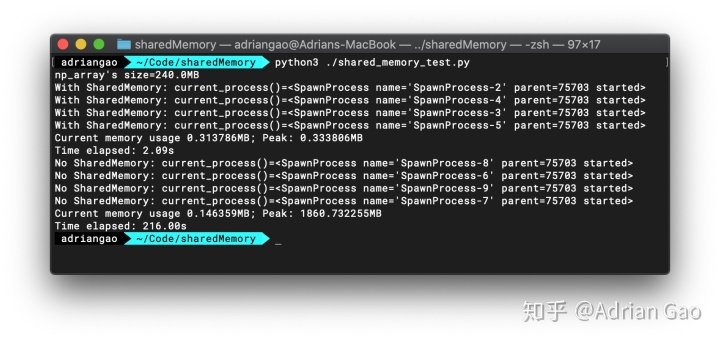最近发了个宏愿想写一个做企业金融研究的Python框架。拖出Python一看已经更新到了3.8,于是就发现了Python 3.8里新出现的模块:multiprocessing.shared_memory。
随手写了个测试。生成一个240MB大小的pandas.DataFrame,然后转换成numpy.recarray。这个DataFarme里包括了datetime,整型和字符串类型的列。使用numpy.recarray的目的是为了保存dtype,这样才能在子进程中正确从共享内存里读数据。 我在子进程中简单地使用numpy.nansum来做计算。第一种方法是使用共享内存,第二种方法是直接将numpy.recarray作为参数传递给子进程。 下图为测试代码的输出。

可以看出,使用共享内存的第一种方法只使用了可以忽略不计的内存,并且2秒结束战斗。传参数的方法使用了1.8GB的内存,并且慢得要命,花费200多秒。当然这跟我使用的测试机是一台2017年的12寸MacBook 4-core i5 8G RAM(已停产)有可能,不过侧面也说明在数据足够大的时候,尽量避免没必要的复制和传递还是很有效的。
测试代码如下:
from multiprocessing.shared_memory import SharedMemory
from multiprocessing.managers import SharedMemoryManager
from concurrent.futures import ProcessPoolExecutor, as_completed
from multiprocessing import current_process, cpu_count
from datetime import datetime
import numpy as np
import pandas as pd
import tracemalloc
import timedef work_with_shared_memory(shm_name, shape, dtype):print(f'With SharedMemory: {current_process()=}')# Locate the shared memory by its nameshm = SharedMemory(shm_name)# Create the np.recarray from the buffer of the shared memorynp_array = np.recarray(shape=shape, dtype=dtype, buf=shm.buf)return np.nansum(np_array.val)def work_no_shared_memory(np_array: np.recarray):print(f'No SharedMemory: {current_process()=}')# Without shared memory, the np_array is copied into the child processreturn np.nansum(np_array.val)if __name__ == "__main__":# Make a large data frame with date, float and character columnsa = [(datetime.today(), 1, 'string'),(datetime.today(), np.nan, 'abc'),] * 5000000df = pd.DataFrame(a, columns=['date', 'val', 'character_col'])# Convert into numpy recarray to preserve the dtypesnp_array = df.to_records(index=False)del dfshape, dtype = np_array.shape, np_array.dtypeprint(f"np_array's size={np_array.nbytes/1e6}MB")# With shared memory# Start tracking memory usagetracemalloc.start()start_time = time.time()with SharedMemoryManager() as smm:# Create a shared memory of size np_arry.nbytesshm = smm.SharedMemory(np_array.nbytes)# Create a np.recarray using the buffer of shmshm_np_array = np.recarray(shape=shape, dtype=dtype, buf=shm.buf)# Copy the data into the shared memorynp.copyto(shm_np_array, np_array)# Spawn some processes to do some workwith ProcessPoolExecutor(cpu_count()) as exe:fs = [exe.submit(work_with_shared_memory, shm.name, shape, dtype)for _ in range(cpu_count())]for _ in as_completed(fs):pass# Check memory usagecurrent, peak = tracemalloc.get_traced_memory()print(f"Current memory usage {current/1e6}MB; Peak: {peak/1e6}MB")print(f'Time elapsed: {time.time()-start_time:.2f}s')tracemalloc.stop()# Without shared memorytracemalloc.start()start_time = time.time()with ProcessPoolExecutor(cpu_count()) as exe:fs = [exe.submit(work_no_shared_memory, np_array)for _ in range(cpu_count())]for _ in as_completed(fs):pass# Check memory usagecurrent, peak = tracemalloc.get_traced_memory()print(f"Current memory usage {current/1e6}MB; Peak: {peak/1e6}MB")print(f'Time elapsed: {time.time()-start_time:.2f}s')tracemalloc.stop()值得一提的是,numpy.ndarray的dtype一定不能是object,不然子进程访问共享内存的时候一定segfault,但如果在主进程里访问共享内存就没事。
补充更新一下,上面的测试代码work_with_shared_memory 函数里不能解引用np_array,比如print(np_array),不然会segfault。使用np_array.val和np_array.date则没有问题则是因为这两个column的dtype不是object。而np_array.character_col的dtype在这个代码里是object。
解决这个问题的办法也很简单,(踩坑无数次后),在to_records()里指定dtype。
np_array = df.to_records(index=False,column_dtypes={'character_col': 'S6'})这里我们指定character_col为长度为6的字符串。 如果是unicode的话,可以将S6换成U6。 超出指定长度的字符串则会被truncate。
这样就不会有segfault了。重点就是不能有object的dtype。

















)

